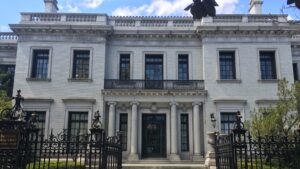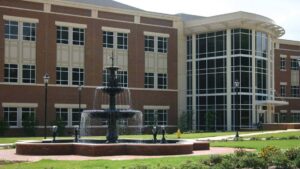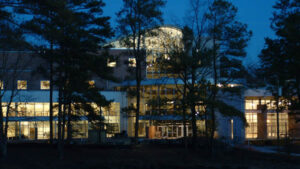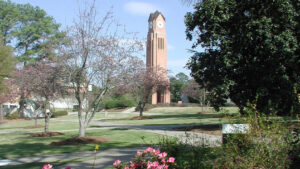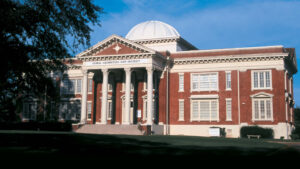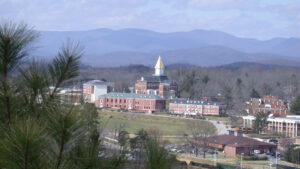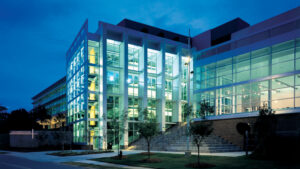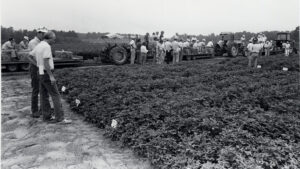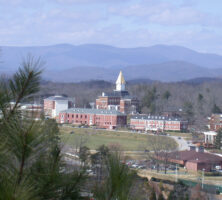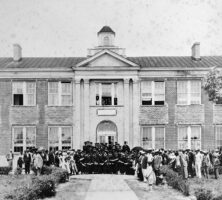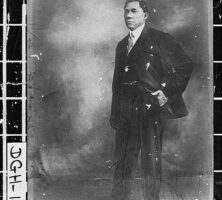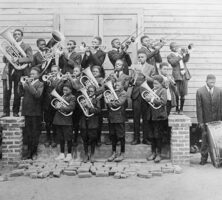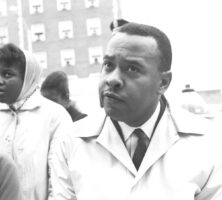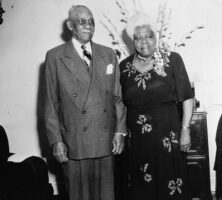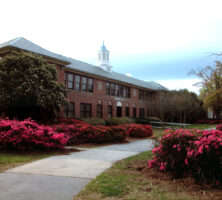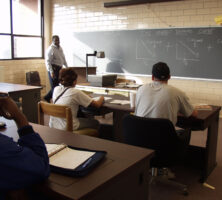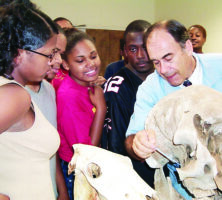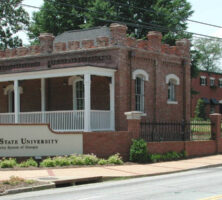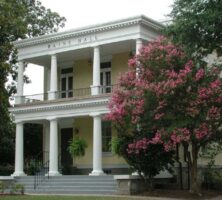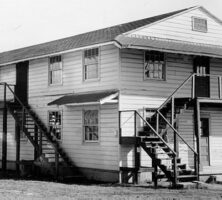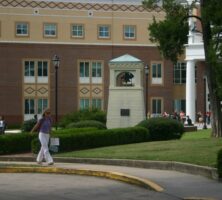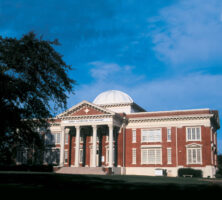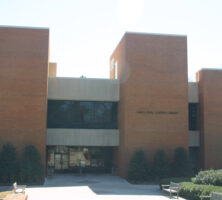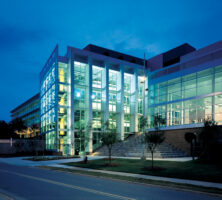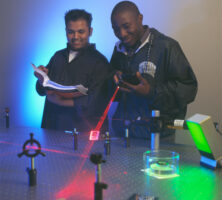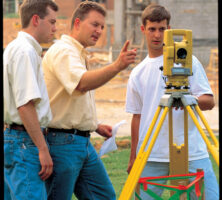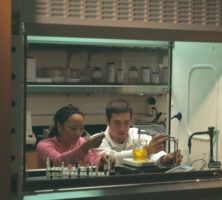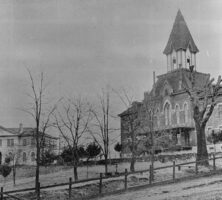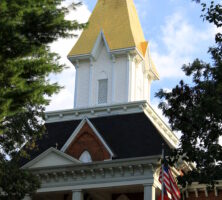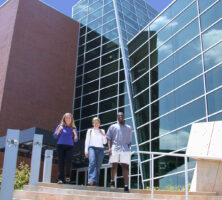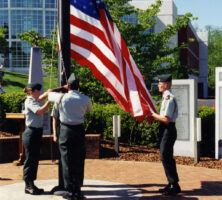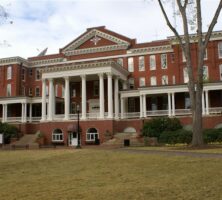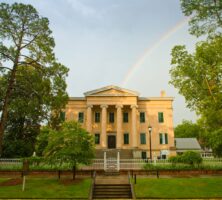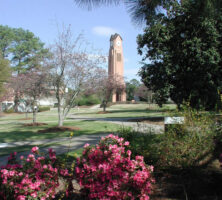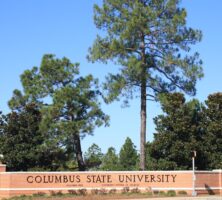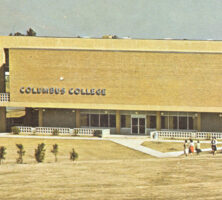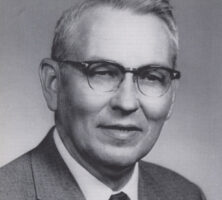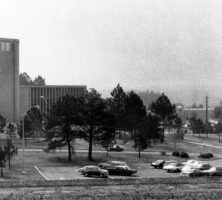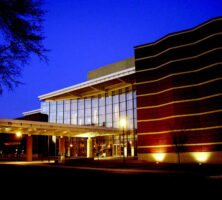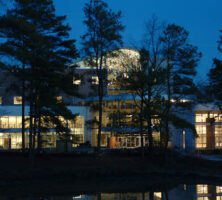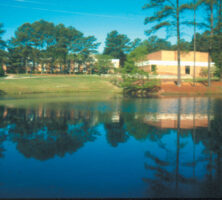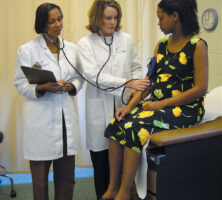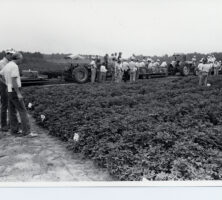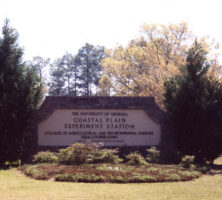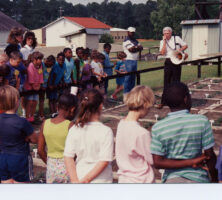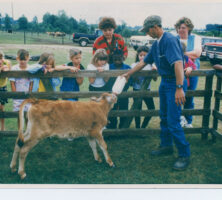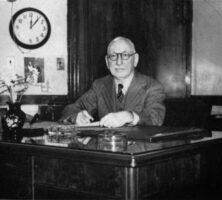The New Georgia Encyclopedia is supported by funding from A More Perfect Union, a special initiative of the National Endowment for the Humanities.
The Blue Ridge Mountains surround the campus of North Georgia College and State University, one of six senior military colleges in the United States.
Courtesy of NGCSU Relations
The New Georgia Encyclopedia does not hold the copyright for this media resource and can neither grant nor deny permission to republish or reproduce the image online or in print. All requests for permission to publish or reproduce the resource must be submitted to the rights holder.
Members of the Georgia Normal and Agricultural College graduating class of 1938 pose with family and friends. The college later became Albany State University.
Courtesy of Georgia Archives, Vanishing Georgia, # dgh137.
The New Georgia Encyclopedia does not hold the copyright for this media resource and can neither grant nor deny permission to republish or reproduce the image online or in print. Requests for permission to publish or reproduce the resource should be submitted to the Georgia Archives.
Joseph Winthrop Holley, pictured circa 1903, founded the Albany Bible and Manual Training Institute in Albany in 1903. He was inspired to open the school by the writings of W. E. B. Du Bois, which describe the poor educational opportunities for Black southerners at that time.
Courtesy of Georgia Archives, Vanishing Georgia, #dgh127.
The New Georgia Encyclopedia does not hold the copyright for this media resource and can neither grant nor deny permission to republish or reproduce the image online or in print. Requests for permission to publish or reproduce the resource should be submitted to the Georgia Archives.
The band for the Georgia Normal and Agricultural College (later Albany State University) plays on Broad Street in downtown Albany, circa 1925. In 1932 the school became part of the University System of Georgia.
Courtesy of Georgia Archives, Vanishing Georgia, # dgh155.
The New Georgia Encyclopedia does not hold the copyright for this media resource and can neither grant nor deny permission to republish or reproduce the image online or in print. Requests for permission to publish or reproduce the resource should be submitted to the Georgia Archives.
Civil rights activist and real estate broker Slater King was one of the leaders of the Albany Movement. To the left is Bernice Johnson, one of the original Student Nonviolent Coordinating Committee Freedom Singers, who later formed the musical group Sweet Honey in the Rock.
Courtesy of Cochran Studios/A. E. Jenkins Photography
The New Georgia Encyclopedia does not hold the copyright for this media resource and can neither grant nor deny permission to republish or reproduce the image online or in print. All requests for permission to publish or reproduce the resource must be submitted to the rights holder.
Joseph Winthrop Holley, the founder of the Albany Bible and Manual Training Institute (later Albany State University) in Albany, is pictured in 1952 with Mary McLeod Bethune, the founder of the Daytona Normal and Industrial Institute for Negro Girls in Florida.
Courtesy of Georgia Archives, Vanishing Georgia, # dgh141.
The New Georgia Encyclopedia does not hold the copyright for this media resource and can neither grant nor deny permission to republish or reproduce the image online or in print. Requests for permission to publish or reproduce the resource should be submitted to the Georgia Archives.
Founders Hall houses the Department of Fine Arts and Humanities at Fort Valley State University in Peach County. Fort Valley State is one of three public historically Black colleges and universities in the state.
Courtesy of Communications Department, College of Agriculture, Home Economics and Allied Programs, Fort Valley State University
The New Georgia Encyclopedia does not hold the copyright for this media resource and can neither grant nor deny permission to republish or reproduce the image online or in print. All requests for permission to publish or reproduce the resource must be submitted to the rights holder.
Students in the College of Agriculture, Home Economics, and Allied Programs at Fort Valley State University attend class. Fort Valley was founded in Peach County as an industrial high school in 1895 and attained university status in 1996.
Courtesy of Communications Department, College of Agriculture, Home Economics and Allied Programs, Fort Valley State University
The New Georgia Encyclopedia does not hold the copyright for this media resource and can neither grant nor deny permission to republish or reproduce the image online or in print. All requests for permission to publish or reproduce the resource must be submitted to the rights holder.
Stinson Troutman (left), an agent with the Cooperative Extension program at Fort Valley State University in Peach County, assists farmers in the surrounding community with making their operations more profitable.
Courtesy of Fort Valley State University Cooperative Extension Program
The New Georgia Encyclopedia does not hold the copyright for this media resource and can neither grant nor deny permission to republish or reproduce the image online or in print. All requests for permission to publish or reproduce the resource must be submitted to the rights holder.
Veterinary students at Fort Valley State University in Peach County gather for an anatomy lecture by Frank Lochner, a professor in the Department of Veterinary Science. The department was established in 1976.
Courtesy of Communications Department, College of Agriculture, Home Economics and Allied Programs, Fort Valley State University
The New Georgia Encyclopedia does not hold the copyright for this media resource and can neither grant nor deny permission to republish or reproduce the image online or in print. All requests for permission to publish or reproduce the resource must be submitted to the rights holder.
The New Georgia Encyclopedia does not hold the copyright for this media resource and can neither grant nor deny permission to republish or reproduce the image online or in print. All requests for permission to publish or reproduce the resource must be submitted to the rights holder.
The New Georgia Encyclopedia does not hold the copyright for this media resource and can neither grant nor deny permission to republish or reproduce the image online or in print. All requests for permission to publish or reproduce the resource must be submitted to the rights holder.
The New Georgia Encyclopedia does not hold the copyright for this media resource and can neither grant nor deny permission to republish or reproduce the image online or in print. All requests for permission to publish or reproduce the resource must be submitted to the rights holder.
Armstrong State University originally occupied the residence of George Ferguson Armstrong, a Savannah shipping executive. At Gamble's request, Armstrong's widow and daughter donated their home, located on the southern edge of Savannah's historic district, to the city to house the new school.
Image from NewTestLeper79
The New Georgia Encyclopedia does not hold the copyright for this media resource and can neither grant nor deny permission to republish or reproduce the image online or in print. All requests for permission to publish or reproduce the resource must be submitted to the rights holder.
University Hall stands at the main entrance of Augusta State University and houses classrooms, laboratories, and departmental offices. Founded in 1925 as the Junior College of Augusta, ASU is today part of the University System of Georgia. The school grants both undergraduate and graduate degrees in education, business, and the liberal arts and sciences.
Courtesy of Augusta State University
The New Georgia Encyclopedia does not hold the copyright for this media resource and can neither grant nor deny permission to republish or reproduce the image online or in print. All requests for permission to publish or reproduce the resource must be submitted to the rights holder.
The U.S. Army operated the Augusta Arsenal, established by U.S. president George Washington in 1819, until 1955. In 1957 the property was transferred to the Junior College of Augusta, which later became Augusta State University.
Courtesy of Augusta State University
The New Georgia Encyclopedia does not hold the copyright for this media resource and can neither grant nor deny permission to republish or reproduce the image online or in print. All requests for permission to publish or reproduce the resource must be submitted to the rights holder.
The Guardhouse Musuem, originally constructed in 1866 as the main entrance to the Augusta Arsenal, is located on the campus of Augusta State University. Restored in 2002, the museum offers displays about the arsenal, university, and surrounding historic neighborhoods.
Courtesy of Augusta State University
The New Georgia Encyclopedia does not hold the copyright for this media resource and can neither grant nor deny permission to republish or reproduce the image online or in print. All requests for permission to publish or reproduce the resource must be submitted to the rights holder.
Rains Hall houses the offices of the university president, advancement, and public relations and publications at Augusta State University. The building is named in honor of Colonel George W. Rains, who reopened the Academy of Richmond County after its closure during the Civil War.
Courtesy of Augusta State University
The New Georgia Encyclopedia does not hold the copyright for this media resource and can neither grant nor deny permission to republish or reproduce the image online or in print. All requests for permission to publish or reproduce the resource must be submitted to the rights holder.
The New Georgia Encyclopedia does not hold the copyright for this media resource and can neither grant nor deny permission to republish or reproduce the image online or in print. All requests for permission to publish or reproduce the resource must be submitted to the rights holder.
The old science building at Augusta State University was used as a holding facility for German prisoners of war during World War II. Converted into classrooms by the school during the 1950s, the building was torn down in the 1990s after the discovery of asbestos roofing material.
Courtesy of Augusta State University
The New Georgia Encyclopedia does not hold the copyright for this media resource and can neither grant nor deny permission to republish or reproduce the image online or in print. All requests for permission to publish or reproduce the resource must be submitted to the rights holder.
The New Georgia Encyclopedia does not hold the copyright for this media resource and can neither grant nor deny permission to republish or reproduce the image online or in print. All requests for permission to publish or reproduce the resource must be submitted to the rights holder.
The new science building at Augusta State University was completed in 2000 and houses the departments of biology, chemistry and physics, and psychology.
Courtesy of Augusta State University
The New Georgia Encyclopedia does not hold the copyright for this media resource and can neither grant nor deny permission to republish or reproduce the image online or in print. All requests for permission to publish or reproduce the resource must be submitted to the rights holder.
Allgood Hall, named in honor of former regent and state sentator Thomas F. Allgood, was opened on the campus of Augusta State University in 2002 and holds classrooms.
Courtesy of Augusta State University
The New Georgia Encyclopedia does not hold the copyright for this media resource and can neither grant nor deny permission to republish or reproduce the image online or in print. All requests for permission to publish or reproduce the resource must be submitted to the rights holder.
The Wheatley Administration Building stands on the campus of Georgia Southwestern State University in Americus. Initially founded as an agricultural school, today the university offers majors toward fifty-two associate, thirty-six baccalaureate, and nineteen master's degrees.
Courtesy of Georgia Southwestern State University
The New Georgia Encyclopedia does not hold the copyright for this media resource and can neither grant nor deny permission to republish or reproduce the image online or in print. All requests for permission to publish or reproduce the resource must be submitted to the rights holder.
The New Georgia Encyclopedia does not hold the copyright for this media resource and can neither grant nor deny permission to republish or reproduce the image online or in print. All requests for permission to publish or reproduce the resource must be submitted to the rights holder.
The James Earl Carter Sr. Library houses more than 190,000 volumes on the campus of Georgia Southwestern State University in Americus. The library is named for the father of U.S. president Jimmy Carter, a graduate of the university.
Courtesy of Georgia Southwestern State University
The New Georgia Encyclopedia does not hold the copyright for this media resource and can neither grant nor deny permission to republish or reproduce the image online or in print. All requests for permission to publish or reproduce the resource must be submitted to the rights holder.
The women's softball team at Georgia Southwestern State University won the conference title in 2002. The university supports a thriving intercollegiate and intermural athletic program, garnering thirty-five conference championships and producing forty-four all-American athletes in its history.
Courtesy of Georgia Southwestern State University
The New Georgia Encyclopedia does not hold the copyright for this media resource and can neither grant nor deny permission to republish or reproduce the image online or in print. All requests for permission to publish or reproduce the resource must be submitted to the rights holder.
The architecture building on the Southern Polytechnic State University (later Kennesaw State University) campus houses the only accredited Bachelor of Architecture degree program in the university system.
Courtesy of Southern Polytechnic State University
The New Georgia Encyclopedia does not hold the copyright for this media resource and can neither grant nor deny permission to republish or reproduce the image online or in print. All requests for permission to publish or reproduce the resource must be submitted to the rights holder.
First called the Technical Institute, Southern Polytechnic State University opened its doors in 1948 to 116 students. In fall 2004, approximately 3,700 students enrolled to pursue a technology-related education. In 2015 the university merged with Kennesaw State University.
Courtesy of Southern Polytechnic State University
The New Georgia Encyclopedia does not hold the copyright for this media resource and can neither grant nor deny permission to republish or reproduce the image online or in print. All requests for permission to publish or reproduce the resource must be submitted to the rights holder.
These physics students take advantage of a high-tech physics lab at Southern Polytechnic State University (later Kennesaw State University). The university often tailored its programs to meet the needs of high-tech businesses in the state.
Courtesy of Southern Polytechnic State University
The New Georgia Encyclopedia does not hold the copyright for this media resource and can neither grant nor deny permission to republish or reproduce the image online or in print. All requests for permission to publish or reproduce the resource must be submitted to the rights holder.
Students at Southern Polytechnic State University (later Kennesaw State University) study surveying and mapping.
Courtesy of Southern Polytechnic State University
The New Georgia Encyclopedia does not hold the copyright for this media resource and can neither grant nor deny permission to republish or reproduce the image online or in print. All requests for permission to publish or reproduce the resource must be submitted to the rights holder.
The New Georgia Encyclopedia does not hold the copyright for this media resource and can neither grant nor deny permission to republish or reproduce the image online or in print. All requests for permission to publish or reproduce the resource must be submitted to the rights holder.
While students could choose between a number of technology-related degrees at Southern Polytechnic State University (later Kennesaw State University), their education was well balanced with courses in the liberal arts. The university placed a strong emphasis on the practical applications of knowledge and technology.
Courtesy of Southern Polytechnic State University
The New Georgia Encyclopedia does not hold the copyright for this media resource and can neither grant nor deny permission to republish or reproduce the image online or in print. All requests for permission to publish or reproduce the resource must be submitted to the rights holder.
Established in 1873, NGCSU was originally called North Georgia Agricultural College. Price Hall, shown here to the right in 1900, was named for founder William P. Price, a Dahlonega lawyer.
Courtesy of Georgia Archives, Vanishing Georgia, # lum078.
The New Georgia Encyclopedia does not hold the copyright for this media resource and can neither grant nor deny permission to republish or reproduce the image online or in print. Requests for permission to publish or reproduce the resource should be submitted to the Georgia Archives.
Built on the foundation of the old Dahlonega Mint, which was destroyed by fire in 1878, Price Memorial Hall on the campus of North Georgia College and State University boasts a steeple plated in Lumpkin County gold.
Image from HollyJoe28
The New Georgia Encyclopedia does not hold the copyright for this media resource and can neither grant nor deny permission to republish or reproduce the image online or in print. All requests for permission to publish or reproduce the resource must be submitted to the rights holder.
The Health and Natural Sciences Building on the campus of North Georgia College and State University was completed in 2001 and houses a planetarium, health science library, and a primary care center.
Courtesy of NGCSU Relations
The New Georgia Encyclopedia does not hold the copyright for this media resource and can neither grant nor deny permission to republish or reproduce the image online or in print. All requests for permission to publish or reproduce the resource must be submitted to the rights holder.
Participation in the ROTC program is required of resident men and optional for commuters and women at North Georgia College and State University. Distinguished military graduates are admitted into the regular army on the same basis as graduates of West Point.
Courtesy of Willam P. Roberts
The New Georgia Encyclopedia does not hold the copyright for this media resource and can neither grant nor deny permission to republish or reproduce the image online or in print. All requests for permission to publish or reproduce the resource must be submitted to the rights holder.
Atkinson Hall is located on the campus of Georgia College and State University in Milledgeville.
Image from C Smith
The New Georgia Encyclopedia does not hold the copyright for this media resource and can neither grant nor deny permission to republish or reproduce the image online or in print. All requests for permission to publish or reproduce the resource must be submitted to the rights holder.
The Old Governor's Mansion in Milledgeville (1838), designed by architect Charles Cluskey, is an example of Greek revival, an architectural style common throughout the state well into the 1850s. The mansion is now part of Georgia College and State University.
Courtesy of Explore Georgia, Photograph by Ralph Daniel.
The New Georgia Encyclopedia does not hold the copyright for this media resource and can neither grant nor deny permission to republish or reproduce the image online or in print. Requests for permission to publish or reproduce the resource may need to be submitted to Explore Georgia.
The New Georgia Encyclopedia does not hold the copyright for this media resource and can neither grant nor deny permission to republish or reproduce the image online or in print. All requests for permission to publish or reproduce the resource must be submitted to the rights holder.
The New Georgia Encyclopedia does not hold the copyright for this media resource and can neither grant nor deny permission to republish or reproduce the image online or in print. All requests for permission to publish or reproduce the resource must be submitted to the rights holder.
The campus clock tower at Columbus State University.
Courtesy of Columbus State University
The New Georgia Encyclopedia does not hold the copyright for this media resource and can neither grant nor deny permission to republish or reproduce the image online or in print. All requests for permission to publish or reproduce the resource must be submitted to the rights holder.
The entrance gates to Columbus State University, which was founded in 1958.
Image from Deutschlandreform
The New Georgia Encyclopedia does not hold the copyright for this media resource and can neither grant nor deny permission to republish or reproduce the image online or in print. All requests for permission to publish or reproduce the resource must be submitted to the rights holder.
The hosiery mill where CSU first opened its doors in September 1958.
Courtesy of Columbus State University
The New Georgia Encyclopedia does not hold the copyright for this media resource and can neither grant nor deny permission to republish or reproduce the image online or in print. All requests for permission to publish or reproduce the resource must be submitted to the rights holder.
Columbus State University began as a junior college in 1958, meeting first in a renovated hosiery mill before moving to its own campus in 1963. The college achieved senior college status in 1965 and awarded its first bachelor's degrees in 1970.
Courtesy of Columbus State University
The New Georgia Encyclopedia does not hold the copyright for this media resource and can neither grant nor deny permission to republish or reproduce the image online or in print. All requests for permission to publish or reproduce the resource must be submitted to the rights holder.
Thomas Whitley was the first president of CSU. He led the institution from its temporary buildings to its move to the permanent campus; he also integrated the school and oversaw the transition to senior college status in 1965.
Courtesy of Columbus State University
The New Georgia Encyclopedia does not hold the copyright for this media resource and can neither grant nor deny permission to republish or reproduce the image online or in print. All requests for permission to publish or reproduce the resource must be submitted to the rights holder.
Columbus College grew rapidly during the late 1960s and early 1970s as baby boomers and Fort Benning soldiers enrolled in classes. By the late 1970s, however, enrollment began to decline following the graduations of baby boomers and personnel cuts at Fort Benning.
Courtesy of Columbus State University
The New Georgia Encyclopedia does not hold the copyright for this media resource and can neither grant nor deny permission to republish or reproduce the image online or in print. All requests for permission to publish or reproduce the resource must be submitted to the rights holder.
Cody the Cougar is the CSU mascot. CSU has been especially successful with men's golf and women's basketball.
Courtesy of Columbus State University
The New Georgia Encyclopedia does not hold the copyright for this media resource and can neither grant nor deny permission to republish or reproduce the image online or in print. All requests for permission to publish or reproduce the resource must be submitted to the rights holder.
The RiverCenter for the Performing Arts, located in the heart of Columbus, houses CSU's Schwob School of Music and features state-of-the-art performance facilities.
Courtesy of Columbus State University
The New Georgia Encyclopedia does not hold the copyright for this media resource and can neither grant nor deny permission to republish or reproduce the image online or in print. All requests for permission to publish or reproduce the resource must be submitted to the rights holder.
Spivey Hall sits on the shore of a small pond on the campus of Clayton State University. Known for its superb acoustics and cozy atmosphere, Spivey Hall patrons have greeted many world renowned musicians since it began its jazz and classical music Concert Series in 1991.
Courtesy of Clayton State University
The New Georgia Encyclopedia does not hold the copyright for this media resource and can neither grant nor deny permission to republish or reproduce the image online or in print. All requests for permission to publish or reproduce the resource must be submitted to the rights holder.
Clayton State University opened in 1969 as Clayton Junior College. The school was granted university status in 1996 and today offers a wide variety of degree programs and majors to a diverse student population.
Courtesy of Clayton State University
The New Georgia Encyclopedia does not hold the copyright for this media resource and can neither grant nor deny permission to republish or reproduce the image online or in print. All requests for permission to publish or reproduce the resource must be submitted to the rights holder.
A student at Clayton State University works on her notebook computer. As part of the university's Information Technology Project, which provides many courses online as well as technologically enhanced classrooms, all students at Clayton State are required to purchase computers.
Courtesy of Clayton State University
The New Georgia Encyclopedia does not hold the copyright for this media resource and can neither grant nor deny permission to republish or reproduce the image online or in print. All requests for permission to publish or reproduce the resource must be submitted to the rights holder.
Nursing students in the School of Health Sciences at Clayton State University take the blood pressure of a patient. Students pursuing a degree in the health sciences acquire practical experience through clinic hours, in addition to their required classroom hours.
Courtesy of Clayton State University
The New Georgia Encyclopedia does not hold the copyright for this media resource and can neither grant nor deny permission to republish or reproduce the image online or in print. All requests for permission to publish or reproduce the resource must be submitted to the rights holder.
Farmers and other agricultural professionals gather in 1987 at the Coastal Plain Experiment Station (later University of Georgia Tifton campus), known as the "Plant Center of the World."
Courtesy of University of Georgia Tifton campus
The New Georgia Encyclopedia does not hold the copyright for this media resource and can neither grant nor deny permission to republish or reproduce the image online or in print. All requests for permission to publish or reproduce the resource must be submitted to the rights holder.
The stone sign at the entrance gate of the Coastal Plain Experiment Station (later University of Georgia Tifton campus), seen here in the 1990s, underscores the permanence of the station's contributions to agricultural research.
Courtesy of University of Georgia Tifton campus
The New Georgia Encyclopedia does not hold the copyright for this media resource and can neither grant nor deny permission to republish or reproduce the image online or in print. All requests for permission to publish or reproduce the resource must be submitted to the rights holder.
Charles Douglas, a retired faculty member of the Coastal Plain Experiment Station (later University of Georgia Tifton campus), explains the importance of water in food and fiber production to a grammar school class and teacher in a photo taken in the 1990s.
Photograph by Ann Rice. Courtesy of University of Georgia Tifton campus
The New Georgia Encyclopedia does not hold the copyright for this media resource and can neither grant nor deny permission to republish or reproduce the image online or in print. All requests for permission to publish or reproduce the resource must be submitted to the rights holder.
A first-grade class on a field trip to the Coastal Plain Experiment Station (later University of Georgia Tifton campus) watches as Mike Cremano feeds a cow.
Courtesy of University of Georgia Tifton campus
The New Georgia Encyclopedia does not hold the copyright for this media resource and can neither grant nor deny permission to republish or reproduce the image online or in print. All requests for permission to publish or reproduce the resource must be submitted to the rights holder.
Thomas Gamble, the mayor of Savannah, and city aldermen established City Junior College in Savannah's historic district in 1935. The school later became Armstrong State University.
Courtesy of Armstrong State University
The New Georgia Encyclopedia does not hold the copyright for this media resource and can neither grant nor deny permission to republish or reproduce the image online or in print. All requests for permission to publish or reproduce the resource must be submitted to the rights holder.
The New Georgia Encyclopedia does not hold the copyright for this media resource and can neither grant nor deny permission to republish or reproduce the image online or in print. All requests for permission to publish or reproduce the resource must be submitted to the rights holder.

